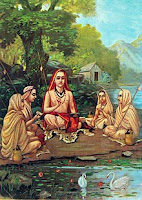Dr. David Frawley, Misconceptions About Advaita, 8/19/19; Dhr. Seven (ed.), Wisdom Quarterly
The Allure of the Direct Path
 |
| OM, I thought nonduality meant One! - It does. - h |
Indeed, one can argue that since the Advaitic state transcends all thought and dualities, all conceptions about it are ultimately misconceptions!
Advaitic practice is itself about the removal of misconceptions, particularly wrong ideas about our true nature -- negating our false identification with the body and the external world.
But misconceptions about this direct path also exist and can be significant obstacles to overcome along the way. Of course, many of these same misconceptions can be found relative to any spiritual path, because all spiritual paths aim to take us to a higher state of consciousness, which can appeal to fantasy and escapism as well as to genuine aspiration.
Yet as Advaita is the highest and most direct path [according to its advocates], this potential for distortion is even greater, like an ordinary climber’s fantasy to quickly scale the heights of Mount Everest.
Advaita is formless in nature and in practice, so there is much room for overestimating, if not exaggerating one’s attainments, and little objective in the practice to keep one grounded.
Going all the way back to the Upanishads there are criticisms of practitioners who can brilliantly talk the Advaitic line but lack the realization to really back it up.
Advaita, though referring to the Brahmic state [of Brahman not Brahma] beyond Maya [Illusion], therefore, has its own glamor or Maya.
The allure of a quick and direct path to becoming God and guru has a special appeal not only to the awakened soul but also to the unawakened ego that wants the glory of spiritual realization without undergoing any real toil or tapas [cleansing austerities] in order to get there.
These usual misconceptions are getting further magnified as Advaita becomes popular in the West, which as a media-dominated culture easily falls into stereotype, image production, and fantasy-fulfillment.
Just as Yoga has undergone many distortions in the West, which has reduced it largely to a physical asana [posture or pose] practice, so too Advaita is often getting reduced to an instant enlightenment fad, to another system of personal empowerment or to another type of pop psychology.
An entire "Neo-Advaitic" movement has arisen reflecting not only traditional Vedantic teachings [the best of the ancient Vedas] but the demands of Western culture. While this movement is arguably a good trend for the future and contains much that is positive in it, it is also a fertile ground for many distortions, which are likely to become more pronounced as the popular base of the movement expands.
The Advaitic path is rooted in a powerful and simple logic, which is not difficult to learn. “You are That,” “The Self is Everything,” “All is One,” and so on.
We can easily confuse adapting this logic, which is not difficult, with the actual realization of the deeper state of awareness behind it, which is something else altogether. We can answer all questions with “Who is asking the question?” when it may be no more than a verbal exercise.
Faced with both old and new misconceptions, the Advaitic student today is in a difficult position to separate a genuine approach and real guidance from the bulk of superficial or misleading teachings, however well-worded, popular, or pleasant in appearance these may appear to be.
Advaita and Vedanta
 |
| The first Hindu: Sri Shankara |
Though rooted in the Vedas, Upanishads, and Bhagavad Gita, its most characteristic form occurs in the teachings of Shankara Acharya (circa 500 AD), who put these Vedic teachings in a clear rational language that remains easily understandable to the present day.
The basic language and logic of Shankara can be found behind most Advaitic teachings, even those who may not have studied [Sri] Shankara directly. More




















































































































































































































































No comments:
Post a Comment